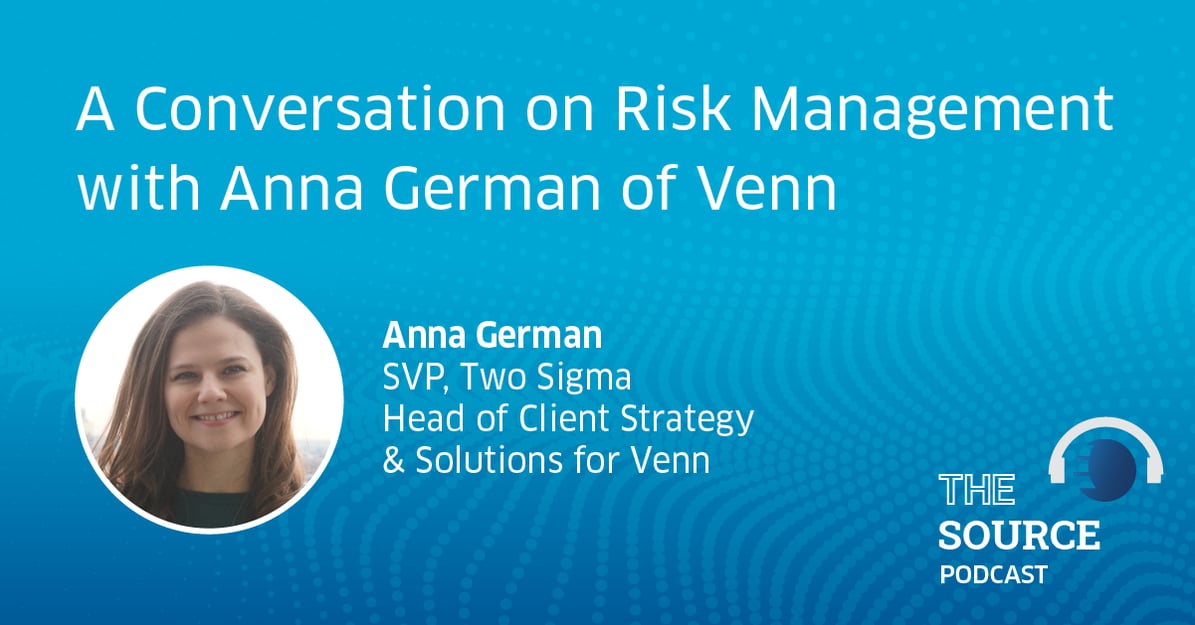
What You’ll Learn From This Conversation:
In this short podcast, Lisa and Anna talk about risk. Many are currently experiencing the effects of major events affecting portfolios, ranging from black swan events like the pandemic to more recent events like inflation and geopolitical crises. These events have impacted how institutional investors need to think about risk when it comes to portfolio management. In this episode, Anna and Lisa discuss how Venn’s quantitative investing solutions can help investors understand risk and navigate the markets.
Venn and eVestment recently announced their strategic alliance. Thanks to this strategic data partnership, subscribers of both Venn and eVestment can access eVestment’s institutional data and market intelligence directly in the Venn analytics platform.
Read the Episode Transcript:
Lisa: Welcome to The Source Podcast. I’m Lisa Terwilliger and I lead strategic partnerships here at eVestment, which is a part of Nasdaq. I’m joined today by Anna German, Senior Vice President at Two Sigma and the Head of Client Strategy and Solutions for the Venn platform. Venn is a cloud-based investment analytics platform that supports data driven insights and investment decision making. Welcome Anna.
Anna: Thanks for having me on, Lisa. I’m excited to be here.
Lisa: We’re really happy you could join us today. In our conversation, we want to talk to you about risk. Over the past few years, we’ve seen a wide range of events affecting portfolios from black swan events, like the pandemic, to more recent events like inflation and geopolitical crises. Two Sigma has long been a leader in quantitative investing and are experts in thinking about risk when it comes to portfolio construction and asset allocation. Anna, can you talk to us a little bit about how Two Sigma thinks about risk and how you’ve navigated the markets in recent times?
Anna: Sure. Two Sigma has historically thought about risk from a thematic and factor based perspective. We look at the drivers of risk that cut across asset classes in assessing risk in our portfolios. Leveraging data sets, we also do things like curate a thematic library that tracks salient themes in the markets. Thematic factors are incorporated into our alpha and risk modeling approaches. Using these lenses can be especially helpful in understanding the impact of events such as the COVID 19 pandemic or the Russia-Ukraine war.
Lisa: It’s very interesting you mentioned the factor based approach to risk there. I’m guessing that’s different from a more traditional asset based approach to risk management. Could you expand a little more there?
Anna: Traditional asset allocation can really bury risk that drives correlation across asset classes. Factors which cut across asset classes are variables that can explain risk and return across a diverse set of investments. Take emerging markets, for example. When we think about EM risk in an investment, we want to isolate that idiosyncratic emerging market exposure, where so much of emerging markets are driven by moves in other asset classes, such as global equities and commodities. So is the drawdown that you see in an EM asset class because of something specific to the EM space or could it simply be explained by a pull back in global equity markets? That’s where applying a factor based lens can be really helpful.
When we built our factor model in Venn, we accounted for this cross correlation. We have several categories or layers of factors, macro factors that cut across all asset classes. Examples would be things like interest rates and commodities. Within this group, we further split up the factors into what we call core and secondary macro factors, and constructed these factors to ensure that they were independent.
If we go back to our emerging market example, emerging market is a secondary macro factor in our model. We stripped out the correlation that you can observe in emerging markets to other macro factors, such as global equities and commodities. As a result, when you see an EM exposure in Venn, that is what I like to think of as a pure EM exposure. And then building on the macro factors, we also layered in style factors, both equity styles, such as size and value, and macro styles such as FX carry and trend following, to help investors better understand their exposures within specific asset classes.
Lisa: Thanks for walking us through that. And it really sounds like your model is giving investors transparency across their portfolio and helping them identify what the most important questions are to ask in an initial due diligence or even an ongoing manager evaluation. We’re excited that eVestment data is now available in the Venn platform, which can help contribute to the scope of investment data in your platform used to support these kinds of analysis.
Anna: Exactly. This can be helpful both in portfolio rebalancing and manager due diligence. Factors are more stable and persistent and empower investors to see trends and ask managers data driven questions. With the eVestment integration in Venn, mutual clients have access to a library of investment managers that are available for instant analysis in Venn, whether that is understanding a manager’s factor exposures or the impact of an allocation to the portfolio’s overall expected performance.
Lisa: I want to pivot slightly and talk about digital transformation, which is something we talk a lot about at eVestment. What are some broader trends you’re seeing in the industry with regards to technology and how it’s changing the way investors do their work?
Anna: We see investors embracing technology more and more, and the pandemic has only reemphasized that trend. Time management, efficiency, getting out of Excel, investment teams are collaborating remotely, evaluating managers virtually. With more data and analytics available in the cloud, it makes for much more efficient collaboration. Investment teams are looking at their tech stacks and processes and asking, “What can we do better, faster, more robustly?” Over the past few years, we have also seen investors expect more from their managers and empower themselves with data to ask smart questions.
Lisa: What advice would you give an investor seeking to enhance their risk management capabilities or resources? What’s a good place to start?
Anna: If you haven’t done so already, or if you haven’t recently reevaluated your analytics capabilities and tools, this is a great time to do so. There are so many software providers on the market that help you focus your time on core investment activities. For example, we’ve heard from clients that our software and the dedicated specialists supporting it have become an extension of their investment team. Technology can really help organizations to scale.
Lisa: That’s great. Anna, thank you again for joining us today. This has been very informative.
Anna: Thank you for having me.
Two Sigma Investor Solutions, LP operates Venn – see here for important disclaimers and disclosures. Venn is for institutional investors only.
This article is not an endorsement by Two Sigma Investor Solutions, LP or any of its affiliates (collectively, “Two Sigma”) of the topics discussed. The views expressed above reflect those of the authors and are not necessarily the views of Two Sigma. This article (i) is only for informational and educational purposes, (ii) is not intended to provide, and should not be relied upon, for investment, accounting, legal or tax advice, and (iii) is not a recommendation as to any portfolio, allocation, strategy or investment. This article is not an offer to sell or the solicitation of an offer to buy any securities or other instruments. This article is current as of the date of issuance (or any earlier date as referenced herein) and is subject to change without notice. The analytics or other services available on Venn change frequently and the content of this article should be expected to become outdated and less accurate over time. Any statements regarding planned or future development efforts for our existing or new products or services are not intended to be a promise or guarantee of future availability of products, services, or features. Such statements merely reflect our current plans. They are not intended to indicate when or how particular features will be offered or at what price. These planned or future development efforts may change without notice. Two Sigma has no obligation to update the article nor does Two Sigma make any express or implied warranties or representations as to its completeness or accuracy. This material uses some trademarks owned by entities other than Two Sigma purely for identification and comment as fair nominative use. That use does not imply any association with or endorsement of the other company by Two Sigma, or vice versa. See the end of the document for other important disclaimers and disclosures. Click here for other important disclaimers and disclosures.
This article may include discussion of investing in virtual currencies. You should be aware that virtual currencies can have unique characteristics from other securities, securities transactions and financial transactions. Virtual currencies prices may be volatile, they may be difficult to price and their liquidity may be dispersed. Virtual currencies may be subject to certain cybersecurity and technology risks. Various intermediaries in the virtual currency markets may be unregulated, and the general regulatory landscape for virtual currencies is uncertain. The identity of virtual currency market participants may be opaque, which may increase the risk of market manipulation and fraud. Fees involved in trading virtual currencies may vary.




